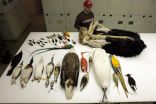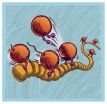(Press-News.org) RIVERSIDE, Calif. - The absence of teeth or "edentulism" has evolved on multiple occasions within vertebrates including birds, turtles, and a few groups of mammals such as anteaters, baleen whales and pangolins. Where early birds are concerned, the fossil record is fragmentary. A question that has intrigued biologists is: Based on this fossil record, were teeth lost in the common ancestor of all living birds or convergently in two or more independent lineages of birds?
A research team led by biologists at the University of California, Riverside and Montclair State University, NJ, has found an answer. Using the degraded remnants of tooth genes in birds to determine when birds lost their teeth, the team reports in the Dec. 12 issue of Science that teeth were lost in the common ancestor of all living birds more than 100 million years ago.
"One of the larger lessons of our finding is that 'dead genes,' like the remnants of dead organisms that are preserved in the fossil record, have a story to tell," said Mark Springer, a professor of biology and one of the lead authors of the study along with Robert Meredith at Montclair State University who was previously a graduate student and postdoctoral researcher in Springer's laboratory. "DNA from the crypt is a powerful tool for unlocking secrets of evolutionary history."
Springer explained that edentulism and the presence of a horny beak are hallmark features of modern birds.
"Ever since the discovery of the fossil bird Archaeopteryx in 1861, it has been clear that living birds are descended from toothed ancestors," he said. "However, the history of tooth loss in the ancestry of modern birds has remained elusive for more than 150 years."
All toothless/enamelless vertebrates are descended from an ancestor with enamel-capped teeth. In the case of birds, it is theropod dinosaurs. Modern birds use a horny beak instead of teeth, and part of their digestive tract to grind up and process food.
Tooth formation in vertebrates is a complicated process that involves many different genes. Of these genes, six are essential for the proper formation of dentin (DSPP) and enamel (AMTN, AMBN, ENAM, AMELX, MMP20).
The researchers examined these six genes in the genomes of 48 bird species, which represent nearly all living bird orders, for the presence of inactivating mutations that are shared by all 48 birds. The presence of such shared mutations in dentin and enamel-related genes would suggest a single loss of mineralized teeth in the common ancestor of all living birds.
Springer, Meredith, and other members of their team found that the 48 bird species share inactivating mutations in both dentin-related (DSPP) and enamel-related genes (ENAM, AMELX, AMTN, MMP20), indicating that the genetic machinery necessary for tooth formation was lost in the common ancestor of all modern birds.
"The presence of several inactivating mutations that are shared by all 48 bird species suggests that the outer enamel covering of teeth was lost around ~116 million years ago," Springer said.
On the basis of fossil and molecular evidence, the researchers propose a two-step scenario whereby tooth loss and beak development evolved together in the common ancestor of all modern birds. In the first stage, tooth loss and partial beak development began on the anterior portion of both the upper and lower jaws. The second stage involved concurrent progression of tooth loss and beak development from the anterior portion of both jaws to the back of the rostrum.
"We propose that this progression ultimately resulted in a complete horny beak that effectively replaced the teeth and may have contributed to the diversification of living birds," Springer said.
The research team also examined the genomes of additional toothless/enamelless vertebrates including three turtles and four mammals (pangolin, aardvark, sloth, and armadillo) for inactivating mutations in the dentin- and enamel-related genes. For comparison, the researchers looked at the genomes of mammalian taxa with enamel-capped teeth.
"All edentulous vertebrate genomes that we examined are characterized by inactivating mutations in DSPP, AMBN, AMELX, AMTN, ENAM, and MMP20, rendering these genes non-functional," Springer said. "The dentin-related gene DSPP is functional in vertebrates with enamelless teeth - sloth, aardvark, armadillo. All six genes are functional in the American alligator, a representative of Crocodylia, the closest living relatives of birds, and mammalian taxa with enamel capped teeth."
The research was supported, in part, by a grant to Springer from the National Science Foundation.
Springer and Meredith were joined in the research by Guojie Zhang at China National GeneBank, China; M. Thomas P. Gilbert at the University of Copenhagen Oster Voldgade, Denmark; and Erich D. Jarvis at Duke University Medical Center, NC.
All the scientists are coauthors with several others, including UC Riverside biologist John Gatesy, on a second paper in the same issue of Science. This paper employs the same 48 bird genomes to ask the question: "What makes a bird a bird?"
"The new bird genomes represent a major advance given that only a handful of bird genomes - zebra finch, turkey, chicken and duck - were previously available," Springer said.
INFORMATION:
The University of California, Riverside (http://www.ucr.edu) is a doctoral research university, a living laboratory for groundbreaking exploration of issues critical to Inland Southern California, the state and communities around the world. Reflecting California's diverse culture, UCR's enrollment has exceeded 21,000 students. The campus opened a medical school in 2013 and has reached the heart of the Coachella Valley by way of the UCR Palm Desert Center. The campus has an annual statewide economic impact of more than $1 billion. A broadcast studio with fiber cable to the AT&T Hollywood hub is available for live or taped interviews. UCR also has ISDN for radio interviews. To learn more, call (951) UCR-NEWS.
LOS ANGELES, Dec. 11, 2014-- It's possible to lastingly persuade conservative voters to support a controversial issue like marriage for same-sex couples--and at a greatly accelerated rate compared to their neighbors--according to groundbreaking data published in this week's issue of the peer-reviewed journal Science. The 12-month study also shows how the Los Angeles LGBT Center's voter persuasion methods reduced anti-gay prejudice and may have the potential to reduce other forms of prejudice.
The independent researchers who led the study, prominent Columbia University ...
This news release is available in Danish and also Chinese on EurekAlert! Chinese.
An international effort to sequence the genomes of 45 avian species has yielded the most reliable tree of life for birds to date. This new avian family tree helps to clarify how modern birds--the most species-rich class of four-limbed vertebrates on the planet--emerged rapidly from a mass extinction event that wiped out all of the dinosaurs approximately 66 million years ago.
It reveals how some of the earliest bird species diverged, answering many long-standing questions about the common ...
SALT LAKE CITY, Dec. 11, 2014 - University of Utah researchers ran biochemical analysis and computer simulations of a livestock virus to discover a likely and exotic mechanism to explain the replication of related viruses such as Ebola, measles and rabies. The mechanism may be a possible target for new treatments within a decade.
"This is fundamental science. It creates new targets for potential antiviral drugs in the next five to 10 years, but unfortunately would not have an impact on the current Ebola epidemic" in West Africa, says Saveez Saffarian, senior author of ...
(SALT LAKE CITY) - Examination of DNA from 21 primate species - from squirrel monkeys to humans - exposes an evolutionary war against infectious bacteria over iron that circulates in the host's bloodstream. Supported by experimental evidence, these findings, published in Science on Dec. 12, demonstrate the vital importance of an increasingly appreciated defensive strategy called nutritional immunity.
"We've known about nutritional immunity for 40 years," says Matthew Barber, Ph.D., first author and postdoctoral fellow in human genetics at the University of Utah. "What ...
How birds evolved to have characteristics including feathers, flight and song is revealed with new clarity in a major study of their family tree.
The international study charts a burst of evolution that took place after the mass extinction of dinosaurs, 66 million years ago. This step-change gave rise to nearly all of the species of birds that we see on the planet today - more than 10,000 varieties.
The four-year project - which included researchers from the University of Edinburgh's Roslin Institute - decoded and compared the entire genetic fingerprint of 48 bird species. ...
Two penguin genomes have been sequenced and analyzed for the first time in the open access, open data journal GigaScience. Timely for the holiday season, the study reveals insights into how these birds have been able to adapt to the cold and hostile Antarctic environment.
Antarctic penguins are subject to extremely low temperatures, high winds, and profound changes in daylight. They have developed complicated biological systems to regulate temperature and store energy for long-term fasting. Most studies have focused on the physiological and behavioral aspects of their ...
DURHAM, N.C. -- His office is filled with all sorts of bird books, but Duke neuroscientist Erich Jarvis didn't become an expert on the avian family tree because of any particular interest in our feathered friends. Rather, it was his fascination with how the human brain understands and reproduces speech that brought him to the birds.
"We've known for many years that the singing behavior of birds is similar to speech in humans -- not identical, but similar -- and that the brain circuitry is similar, too," said Jarvis, an associate professor of neurobiology at the Duke ...
VIDEO:
A microscopy system continuously measures responses to signaling chemicals in thousands of cells at a time.
Click here for more information.
Scientists have discovered a general principle for how cells could accurately transmit chemical signals despite high levels of noise in the system, they report in Science this week.
A cell's response to outside chemical signals depends on its physiological state, which can fluctuate considerably. Amounts of different kinds ...
The entire semiconductor industry, not to mention Silicon Valley, is built on the propensity of electrons in silicon to get kicked out of their atomic shells and become free. These mobile electrons are routed and switched though transistors, carrying the digital information that characterizes our age.
An international team of physicists and chemists based at the University of California, Berkeley, has for the first time taken snapshots of this ephemeral event using attosecond pulses of soft x-ray light lasting only a few billionths of a billionth of a second.
While ...
CHAMPAIGN, Ill. - Where did the songbird get its song? What branch of the bird family tree is closer to the flamingo - the heron or the sparrow?
These questions seem simple, but are actually difficult for geneticists to answer. A new, sophisticated statistical technique developed by researchers at the University of Illinois and the University of Texas at Austin can help researchers construct more accurate species trees detailing the lineage of genes and the relationships between species.
The method, called statistical binning, was used in the Avian Phylogenetics Project, ...




